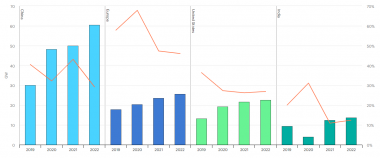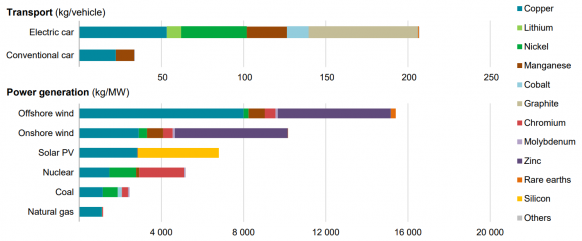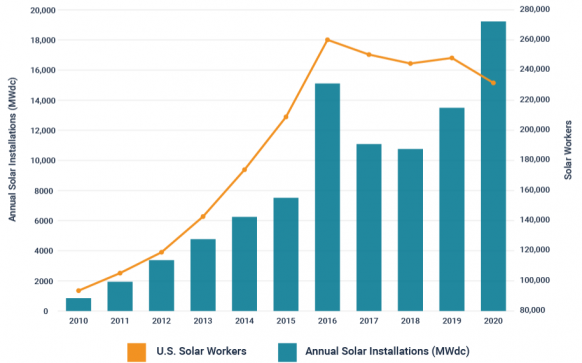IEA hikes renewables forecast by 25%; US solar jobs fell 7% in 2020
Our pick of the latest solar news you need to know.

Related Articles
IEA raises renewables forecast after 2020 jump
The International Energy Agency (IEA) has raised its forecast for new renewable energy capacity in 2021-2022 by over 25% after installations in 2020 far exceeded its predictions.
Renewable energy installations hiked by 45% in 2020 to 280 GW, the largest year-on-year increase since 1999, and installations are now forecast at 270 GW in 2021 and 280 GW in 2022, the IEA said May 11.
"Those forecasts have been revised upwards by more than 25% from the IEA’s previous estimates in November as governments around the world have auctioned record levels of renewable capacity and companies have signed record-level power purchase agreements [PPAs], even as the pandemic spread macroeconomic uncertainties and suppressed demand," it said.
PV installations will continue to rise and offset lower wind additions in 2021-2022, the agency said.
"Solar PV development will continue to break records, with annual additions reaching 162 GW by 2022 – almost 50% higher than the pre-pandemic level of 2019," it said.
Global solar forecast by region
(Click image to enlarge)
Source: International Energy Agency (IEA), May 2021
IEA raised its US forecast following the extension of federal tax credits in December. New US emissions reductions targets and the $2 trillion infrastructure bill proposed by President Biden would have an impact after 2022, the agency noted.
In Europe, further policy support and a "booming" corporate PPA market due to falling PV costs will drive growth, the IEA said.
Minerals shortages could hamper renewables growth, IEA says
Global policy makers must take action to avoid shortages of raw materials and price hikes that could endanger global carbon reduction objectives, the International Energy Agency (IEA) said in a new report published May 5.
Demand for lithium and other minerals used in battery storage and electric vehicles could grow by at least 30 times by 2040, under a "climate-driven scenario," the IEA said. Demand for minerals directly used in solar and wind assets could triple, it said.
"Production and processing of many minerals such as lithium, cobalt and some rare earth elements are highly concentrated in a handful of countries, with the top three producers accounting for more than 75% of supplies," the agency said. "Complex and sometimes opaque supply chains also increase the risks that could arise from physical disruptions, trade restrictions or other developments in major producing countries."
Mineral demand by power generation type
(Click image to enlarge)
Source: International Energy Agency (IEA), May 2021.
Governments should set out long-term commitments on emissions reductions to encourage supply chain investments, promote new technologies and scale up recycling sectors to relieve the pressure on primary supplies, the IEA said.
“Today, the data shows a looming mismatch between the world’s strengthened climate ambitions and the availability of critical minerals that are essential to realising those ambitions,” Fatih Birol, Executive Director of the IEA, said.
“By acting now and acting together, [governments] can significantly reduce the risks of price volatility and supply disruptions.”
US solar employment falls 7% in pandemic year
US solar employment fell by 6.7% last year to 231,474 workers as coronavirus restrictions curbed activity and productivity rose, industry group Solar Foundation said in its latest National Solar Jobs Census.
Before the pandemic, US solar employment was forecast to rise to 302,000 jobs as new installations soared to record levels, the US Solar Energy Industry Association (SEIA), a co-author of the census, said. By May 2020, the US solar industry had cut 65,000 jobs due to COVID-19 and cancelled the creation of around 50,000 positions, it said.
In the end, US solar installations hiked by 43% last year to a record 19.2 GW as utility-scale developers overcame challenges to meet tax credit deadlines. Labour productivity in the utility-scale statement soared by 32% while productivity in the residential market rose 19%, the census said. Many solar companies have not yet reached pre-pandemic employment levels, the report warned.
"The pandemic took a toll on residential jobs in the summer, and those jobs did not fully recover by the end of the year," it said.
Utility-scale developers are building larger projects and using analytics and technology solutions to gain economies of scale. Improved plant layouts and installation approaches are also increasing labor efficiency.
US solar employment, installations
(Click image to enlarge)
Source: US National Solar Jobs Census 2020
The US solar workforce will need to reach 900,000 workers to achieve President Joe Biden's goal of decarbonising the US power sector by 2035, the SEIA warned.
To accelerate deployment, Biden plans to extend investment tax credit (ITC) programs for solar and energy storage by 10 years and implement an ITC for new transmission lines as part of a new $2-trillion infrastructure package unveiled March 31. The White House also aims to pass a law requiring electricity suppliers source 80% of power from zero-carbon sources by 2030.
US approves 350 MW solar-storage project in California desert
The US Bureau of Land Management (BLM) has approved Recurrent Energy's 350 MW Crimson solar plus storage project on federal land in Riverside County, California, the Department of the Interior (DOI) announced May 3.
The $550 million project will be located on a 2,000-acre site located 13 miles west of the city of Blythe and will include 350 MW of energy storage capacity, the DOI said.
The approval follows an order by the Biden administration in January to accelerate federal siting and permitting processes for clean energy and transmission projects.
“America’s public lands provide a tremendous opportunity to realize the potential of renewable energy. BLM is committed to engaging in an inclusive and equitable process in pursuit of a clean energy economy,” Laura Daniel-Davis, Principal Deputy Assistant Secretary of Land and Minerals, said.
Recurrent Energy, a subsidiary of Canadian Solar, is among a growing number of developers including storage in their projects to access higher power prices during the evening.
President Biden wants to decarbonise the power sector by 2035 and large-scale solar and storage will play a crucial role. Recent modelling of Los Angeles showed that faster buildout of PV plus storage is required to decarbonise by 2035 while new transmission corridors would lift the outlook for stand-alone PV.
Reuters Events



